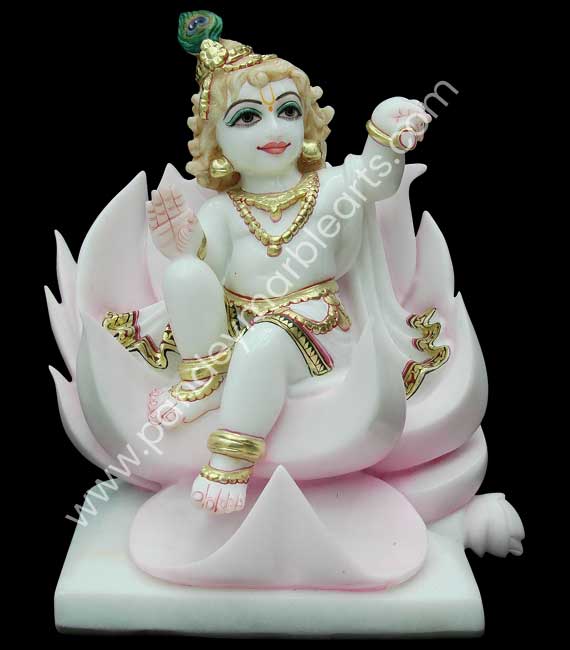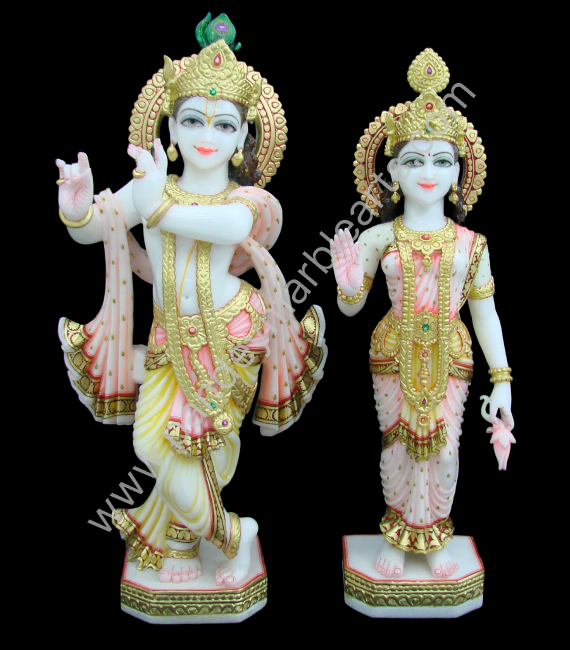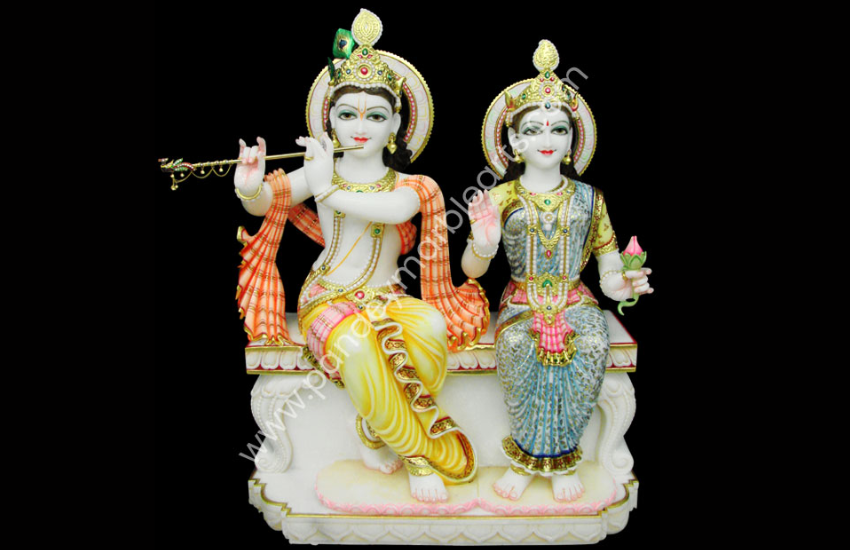There is no doubt that natural stone statues are superior to those made from other materials in terms of quality, beauty, durability, and aesthetics. That’s the reason why most Indian households give preference to marble god statues in contrast to those made with marble dust, fiber, resin, or crystal.
Since statues made with these materials can easily break or decompose with time, natural stone statues would last with you for ages. Additionally, marble is considered the purest material for Hindu gods’ idol making and is thought to have prana (living energy within it).
However, not all marble moortis you are buying online or offline are made from the best quality of the material. Nowadays, it is common practice among some sellers to sell marble dust idols as originals, deceiving devotees’ faith and trust.
To help you out with choosing the best quality marble murtis of Hindu gods and goddesses, we have created this buying guide that highlights the key factors to consider before making a purchase. Alongside, you will also get a checklist to evaluate the quality of the idols and how you can differentiate between the genuine and the fake ones.
What Factors Define the Quality of a Marble Statue?
The quality of a marble statue depends on several clear factors that directly affect its beauty, durability, and value. Here are some of the main factors to consider:
- Type of Marble: The type of marble used in making the idol greatly defines its quality. Natural white marble, bainslana black Indian marble, and Italian marbles are considered the finest for moorti making. They are known to have a smooth texture, high strength, and everlasting shine.
- Craftsmanship: The skills of the artisan show in the idol’s detailing. Sharp facial features, fine ornaments, expressive eyes, and balanced proportions add life to the murti.
- Polishing and Finishing: A quality marble statue of gods has a smooth finish, a glossy surface without cracks or uneven edges. It shows the true craftsmanship of an artist.
- Durability and Thickness: A pure white god moorti has a strong, solid structure with no hidden joints or weak spots, which makes it durable enough to last for decades.
- Aesthetic Appeal: The overall look of the statue should feel peaceful, divine, and elegant. Handcrafted idols are valued more for their divineness and spiritual presence.

Key Checklist to Evaluate a Marble God Moorti Before Buying
When buying a marble god moorti, it is important to check its quality carefully. A statue carries spiritual value and should last for generations.
Below is a detailed checklist to help you evaluate a marble murti before making a purchase.
#1. Purity of Marble
The first thing you need to ask the seller is about the purity of the marble used in making. Natural white Makrana marble and high-grade Italian marble are considered the best. Pure marble has a uniform texture, smoothness, and shine. Avoid statues made with marble dust or artificial mixes, as they lose strength & beauty over time and don’t hold spiritual energies.
#2. Surface Finish
A high-quality marble moorti has a smooth finish and hardly has any patches visible. It feels smooth when touched and has even polishing. A well-polished surface protects the statues from dust and increases their divine aura.
#3. Fine Detailing
If you want to feel the craftsmanship of an artist, look closely at the idol’s face, eyes, hands, and ornaments. You can see the quality of carving in the details. Sharp features, clean cuts, and balanced expressions are some of the traits of high-quality statues.
#4. Absence of Cracks & Discoloration
If you are buying a marble murti from an offline seller, inspect for cracks, spots, or discoloration. Even a hairline crack can weaken the stone over time. At the same time, prefer moortis with even and consistent color in every detail, even in the smallest details like the flute of a Radha Krishna moorti or the trunk (sund) of a Ganesh Ji marble moorti.
#5. Proportion & Symmetry
Symmetry is one of the most important aspects of buying a marble god’s moortis for the home. The statue must look balanced from all sides. The size of the hands, eyes, legs, posture, and facial features all must be in proper proportion.
#6. Weight & Durability
A pure marble moorti has good weight and strength. Always remember that if the statue feels too lightweight to you, there are chances that it is made from fiber or other less durable material. Check the thickness of the marble and ensure there are no hidden joints that may break easily.
#7. Paint & Ornament Work
Many marble god moortis have detailed painting and ornament designs. The paint should be neat, not smudged, and should highlight the features instead of covering them. Gold foil or ornament work must be applied with precision, as untidy decoration reduces the statue’s grace.
#8. Craftsmanship Authenticity
Every moorti reflects the skill of the artisan. Authentic craftsmanship is visible in lifelike expressions, natural hand postures, and clean engraving of ornaments. Machine-made statues lack the emotional touch that a handcrafted moorti carries.

#9. Source & Seller Reliability
Before you make a purchase, consider asking the source of the material used in the moorti making. As said above, makrana and Italian marble are considered the finest for god idols. And always buy from trusted sellers like Pandey Moorti Bhandar. A reliable seller ensures that you are investing in a high-quality, authentic piece that will last for generations.
#10. Value for Price
Be cautious while comparing price and quality. Many sellers these days mislead buyers by selling marble dust or mixed-material moortis in the name of genuine marble, often at the same cost. True value comes only when you get pure marble with fine detailing and durability that justifies the investment.
How Can You Differentiate Between a Genuine and a Fake Marble God Idol?
The biggest challenge buyers face while purchasing a marble god idol is knowing if it is made of pure marble or from low-quality materials like marble dust, resin, or plaster. Experienced artisans and long-time buyers often judge a marble idol’s authenticity through details that are not obvious to everyone. While surface shine or weight may give some hints, there are deeper signs that separate genuine marble from imitations.
One insider tip is to notice the natural veins in the stone. Real marble, especially Makrana or Italian, has faint, irregular patterns that occur naturally. Fake idols made from marble dust or resin have uniform coloring with no depth, which looks too perfect and flat.
At the same time, pure marble feels naturally cool to the touch, even in warm weather. Artificial idols usually match the surrounding temperature and lack that cooling effect.
Pay close attention to the edges and fine carvings. In genuine marble idols, even tiny details like the eyelids, jewelry lines, or folds of clothing remain sharp after polishing. Fake idols often blur at the edges because dust and resin cannot hold fine cuts with the same strength.
Conclusion
Choosing a marble god moorti requires attention to purity, detailing, finishing, durability, and the authenticity of craftsmanship. In the end, it is not about buying idols for home decor but about bringing home a divine presence that carries spiritual value for generations.
At the same time, buyers must remain cautious of sellers who pass off idols made from low-quality material as genuine marble, often at the same price. This makes it essential to rely on trusted sellers who value both tradition and honesty.
Pandey Moorti Bhandar has earned this trust over decades by offering idols crafted from pure Makrana and high-quality marble, shaped by skilled artisans. We are honored to have crafted the Ram Darbar and many other deities’ moortis for the prestigious Ram Mandir at Ayodhya.
FAQs
Which Marble is Best for Making God Statues?
Makrana marble and Italian marble are considered the best for god statues because of their purity, durability, smooth texture, and ability to retain shine for generations.
How do I Maintain and Clean a Marble God Moorti?
Clean with a soft dry or slightly damp cloth. Avoid harsh chemicals, acidic cleaners, or scrubbing, as they can damage the surface and natural shine of marble. Use gentle fabric cleansers and wipe with a wet cloth to remove residue.
Why are Handmade Marble God Statues More Valuable?
Handmade statues carry fine detailing, symmetry, and a soulful touch that machines cannot replicate. Skilled artisans bring life to stone, making each handcrafted piece unique and divine.
Can Painted Marble Idols Lose Their Color Over Time?
Yes, painted idols may fade with time, especially if exposed to sunlight, moisture, or chemicals. They may need re-painting over time.
Why do the Prices of Marble God Idols Vary So Much?
Prices vary due to marble type, size, craftsmanship, detailing, and finishing. Pure Makrana marble with intricate handmade carving costs more than statues made with marble dust or resin.
Can Marble Idols be Customized According to Personal Requirements?
Yes, experienced artisans can craft customized marble idols as per size, posture, or design preferences. Custom work ensures the idol perfectly matches personal or temple requirements.

